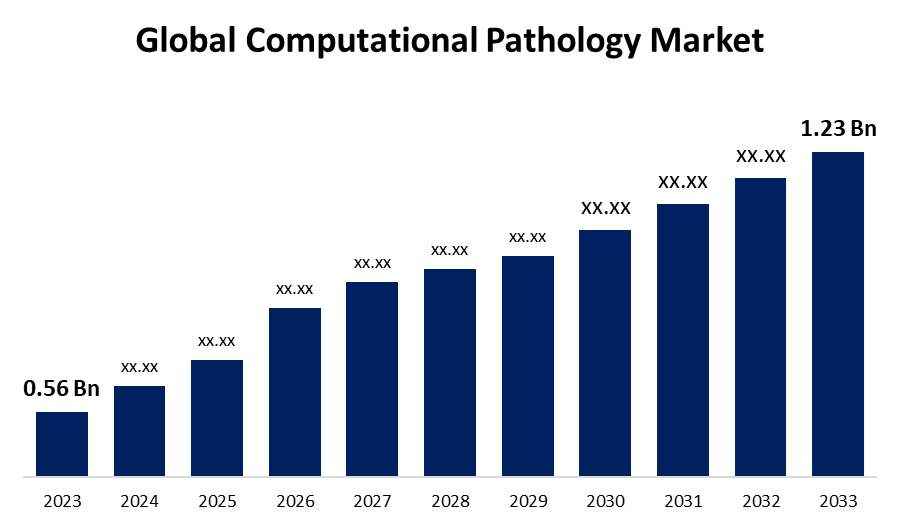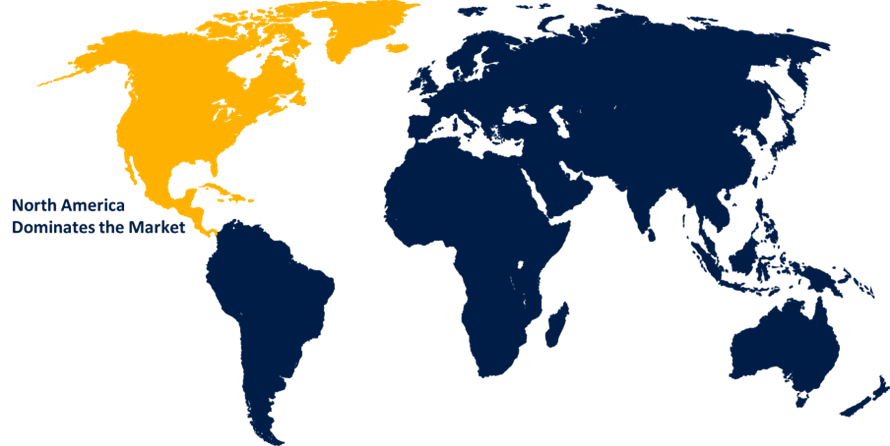Global Computational Pathology Market Size, Share, and COVID-19 Impact Analysis, By Component (Software and Services), By Application (Disease Diagnosis, Drug Discovery & Development and Academic Research), By End User (Hospitals and Diagnostic Labs, Biotechnology and Pharmaceutical Companies, Academic and Research Institutes and Others), and By Region (North America, Europe, Asia-Pacific, Latin America, Middle East, and Africa), Analysis and Forecast 2023 - 2033.
Industry: Information & TechnologyGlobal Computational Pathology Market Insights Forecasts To 2033
- The Global Computational Pathology Market Size was Estimated at USD 0.56 Billion in 2023
- The Market Size is Expected to Grow at a CAGR of around 8.19% from 2023 to 2033
- The Worldwide Computational Pathology Market Size is Expected to Reach USD 1.23 Billion by 2033
- Asia Pacific is Expected to Grow the fastest during the forecast period.

Get more details on this report -
The global computational pathology market size was worth around USD 0.56 billion in 2023 and is predicted to grow to around USD 1.23 billion by 2033 with a compound annual growth rate (CAGR) of 8.19% between 2023 and 2033. The computational pathology market is propelled by technological progress in AI and digital imaging, growing demand for precise and quicker diagnostics, escalating prevalence of chronic diseases, implementation of precision medicine, regulatory clearances, enhanced workflow efficiency, and increased adoption of telepathology.
Market Overview
The term computational pathology industry refers to the business related to the application of digital technologies, machine learning (ML), and artificial intelligence (AI) to aid in the analysis and interpretation of pathology information. This business is all about the creation and deployment of computer tools, software, and platforms that aim to automate, optimize, and improve the accuracy of disease diagnosis, including cancer, cardiovascular diseases, and other chronic diseases, through digital pathology methods. Further, the creation of these solutions provides the means to quickly and accurately analyze images, enabling pathologists to recognize patterns that could represent disease progression. Through automating routine tasks, AI allows pathologists to concentrate on more intricate diagnostic issues, thus enhancing efficiency and accuracy. This change increases diagnostic accuracy and facilitates the creation of personalized medicine via predictive modeling. As healthcare professionals increasingly rely on telepathology to better utilize resources and improve patient care, this change is contributing significantly to market growth. For instance, in June 2023, Zomedica Corp. released the TRUVIEW platform, a veterinary diagnostics solution combining telepathology and digital imaging with the myZomedica web portal, supporting remote image sharing and consultations from expert pathologists. Developments such as TRUVIEW are driving telepathology adoption and helping drive growth in the computational pathology market more broadly.
Report Coverage
This research report categorizes the computational pathology market based on various segments and regions forecasts revenue growth and analyzes trends in each submarket. The report analyses the key growth drivers, opportunities, and challenges influencing the computational pathology market. Recent market developments and competitive strategies such as expansion, type launch, development, partnership, merger, and acquisition have been included to draw the competitive landscape in the market. The report strategically identifies and profiles the key market players and analyses their core competencies in each sub-segment of the computational pathology market.
Global Computational Pathology Market Report Coverage
| Report Coverage | Details |
|---|---|
| Base Year: | 2023 |
| Market Size in 2023: | USD 0.56 Billion |
| Forecast Period: | 2023 - 2033 |
| Forecast Period CAGR 2023 - 2033 : | 8.19% |
| 2033 Value Projection: | USD 1.23 Billion |
| Historical Data for: | 2019 - 2022 |
| No. of Pages: | 220 |
| Tables, Charts & Figures: | 110 |
| Segments covered: | By Component, By Application, By End User and By Region |
| Companies covered:: | Leica Biosystems Nussloch GmbH (Danaher), Hamamatsu Photonics, Inc., Koninklijke Philips N.V., Olympus Corporation, F. Hoffmann-La Roche Ltd., Mikroscan Technologies, Inc., Epredia (3DHISTECH Ltd.), Visiopharm A/S, Proscia Inc., Tempus, and Others |
| Pitfalls & Challenges: | COVID-19 Empact, Challenges, Future, Growth, & Analysis |
Get more details on this report -
Driving Factors
The demand for quicker and more precise diagnostics, especially in diseases such as cancer, is a strong driving factor. Computational pathology facilitates the speedy analysis of tissue samples through AI, enhancing diagnostic accuracy and decreasing turnaround time, thereby fulfilling the requirement for more effective healthcare solutions. Additionally, machine learning and AI have transformed the computational pathology market by offering potent image analysis tools that significantly boost the accuracy and speed of diagnoses. These technologies are capable of detecting intricate patterns on pathology slides, empowering pathologists to provide more accurate and informed decisions and propelling the growth of the market.
Restraining Factors
Implementation of computational pathology solutions in hospitals and diagnostic laboratories entails heavy upfront costs for digital imaging equipment, software, and infrastructure. The acquisition of AI-driven diagnostic tools and staff training may also be prohibitive, particularly in resource-poor settings. Moreover, healthcare practitioners may resist changing to new technology due to familiarity with existing methodologies and uncertainty about the dependability of AI-based systems. Pathologists and clinicians may hesitate to trust automated tools over their expertise, slowing the integration of computational pathology into daily practices.
Market Segmentation
The computational pathology market share is classified into component, application, and end user.
- The software segment dominated the market in 2023 and is projected to grow at a substantial CAGR during the forecast period.
Based on the component, the computational pathology market is divided into software and services. Among these, the software segment dominated the market in 2023 and is projected to grow at a substantial CAGR during the forecast period. The growth is driven by software solutions are the backbone of computational pathology. They encompass image analysis, AI algorithms, and machine learning models that support the automated interpretation of pathology slides. As the market becomes more inclined towards digital pathology tools, software is still a major element driving growth and innovation.
- The disease diagnosis segment accounted for a significant share in 2023 and is anticipated to grow at a remarkable CAGR during the forecast period.
Based on the application, the computational pathology market is divided into disease diagnosis, drug discovery & development, and academic research. Among these, the disease diagnosis segment accounted for a significant share in 2023 and is anticipated to grow at a remarkable CAGR during the forecast period. The segmental growth is due to diagnosis of disease is the main use of computational pathology, in which hospitals and diagnostic laboratories employ it to diagnose tissue samples for diseases, particularly cancer. Through AI and digital pathology software, pathologists can examine slides more effectively and with greater precision, making disease diagnosis the major market driver.
- The hospitals and diagnostic segment accounted for the biggest share in 2023 and is anticipated to grow at a significant CAGR during the forecast period.
Based on the end user, the computational pathology market is divided into hospitals and diagnostic labs, biotechnology and pharmaceutical companies, academic and research institutes, and others. Among these, the hospitals and diagnostic segment accounted for the biggest share in 2023 and is anticipated to grow at a significant CAGR during the forecast period. The growth is attributed to hospitals and diagnostic labs receiving a high number of patient samples every day, especially for diseases such as cancer. Computational pathology assists in dealing with this demand effectively by computerizing slide analysis, enhancing accuracy, and accelerating diagnostic pipelines. This decreases diagnostic turnaround time and helps in better patient outcomes.
Regional Segment Analysis of the Computational Pathology Market
- North America (U.S., Canada, Mexico)
- Europe (Germany, France, U.K., Italy, Spain, Rest of Europe)
- Asia-Pacific (China, Japan, India, Rest of APAC)
- South America (Brazil and the Rest of South America)
- The Middle East and Africa (UAE, South Africa, Rest of MEA)
North America is anticipated to hold the largest share of the computational pathology market over the predicted timeframe.

Get more details on this report -
North America is anticipated to hold the largest share of the computational pathology market over the predicted timeframe. North America's strong healthcare systems, particularly in the United States and Canada, are well-equipped with digital imaging, electronic medical records, and cloud integration. Such base technologies establish a prepared setup for embracing computational pathology, which enables high-throughput diagnostic processes and precision medicine. Key players in computational pathology such as PathAI, Paige, and Proscia are based in North America. Their proximity to healthcare networks, regulators, and research institutions permits rapid product development, on-the-ground testing, and deployment, which adds strength to the region's leadership in market share.
Asia Pacific is expected to grow at a rapid CAGR in the computational pathology market during the forecast period. Many Asia-Pacific nations are digitizing medicine with electronic records, telemedicine, and intelligent diagnostics. The transition facilitates accelerated deployment of computational pathology systems, particularly in new or renovated hospitals that embrace a digital-first approach from the very beginning. Asia-Pacific, which has more than half the globe's population and increasing cancer prevalence, has an enormous diagnostic workload. Computational pathology provides scalable, effective solutions to address growing demand, especially in urban areas where large populations are covered by centralized laboratories with limited pathology personnel.
Competitive Analysis:
The report offers the appropriate analysis of the key organizations/companies involved within the computational pathology market along with a comparative evaluation primarily based on their type of offering, business overviews, geographic presence, enterprise strategies, segment market share, and SWOT analysis. The report also provides an elaborative analysis focusing on the current news and developments of the companies, which includes type development, innovations, joint ventures, partnerships, mergers & acquisitions, strategic alliances, and others. This allows for the evaluation of the overall competition within the market.
List of Key Companies
- Leica Biosystems Nussloch GmbH (Danaher)
- Hamamatsu Photonics, Inc.
- Koninklijke Philips N.V.
- Olympus Corporation
- F. Hoffmann-La Roche Ltd.
- Mikroscan Technologies, Inc.
- Epredia (3DHISTECH Ltd.)
- Visiopharm A/S
- Proscia Inc.
- Tempus
- Others
Key Target Audience
- Market Players
- Investors
- End-users
- Government Authorities
- Consulting And Research Firm
- Venture capitalists
- Value-Added Resellers (VARs)
Recent Development
- In July 2024, Proscia launched a significant update to its Concentriq AP platform, the world's first multi-AI workflow. The new feature enables pathologists to compare the results of various AI applications side by side for the same image, which maximizes diagnostic productivity. The upgrade features support for DICOM images, enhanced API for supporting third-party AI apps, and native language support for 13 languages. All these enhancements will support 100% digitization within laboratories.
Market Segment
This study forecasts revenue at global, regional, and country levels from 2023 to 2033. Spherical Insights has segmented the computational pathology market based on the below-mentioned segments:
Global Computational Pathology Market, By Component
- Software
- Services
Global Computational Pathology Market, By Application
- Disease Diagnosis
- Drug Discovery & Development
- Academic Research
Global Computational Pathology Market, By End User
- Hospitals and Diagnostic Labs
- Biotechnology and Pharmaceutical Companies
- Academic and Research Institutes
- Others
Global Computational Pathology Market, By Regional Analysis
- North America
- US
- Canada
- Mexico
- Europe
- Germany
- UK
- France
- Italy
- Spain
- Russia
- Rest of Europe
- Asia Pacific
- China
- Japan
- India
- South Korea
- Australia
- Rest of Asia Pacific
- South America
- Brazil
- Argentina
- Rest of South America
- Middle East & Africa
- UAE
- Saudi Arabia
- Qatar
- South Africa
- Rest of the Middle East & Africa
Need help to buy this report?